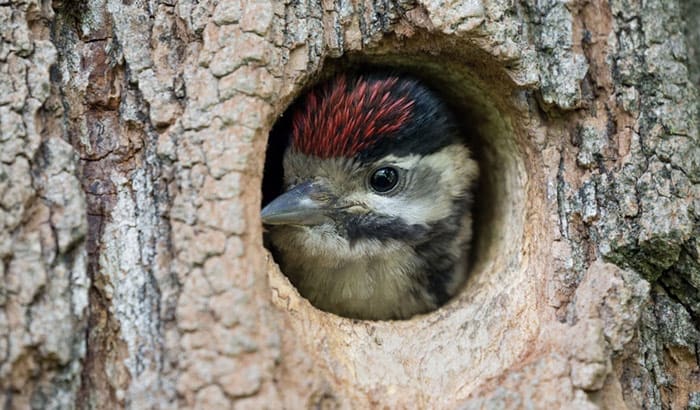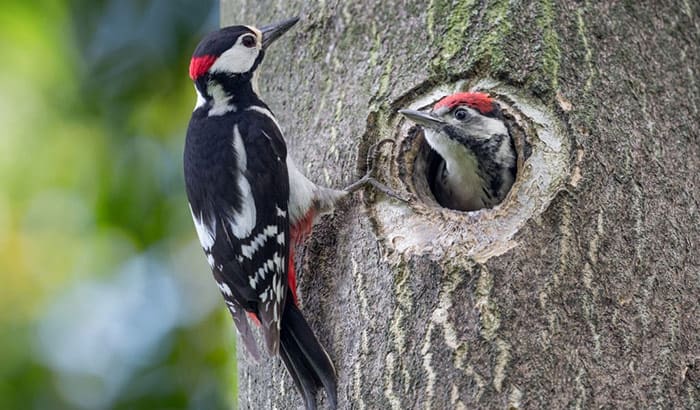Woodpeckers are a common bird that many people have seen before. They fly from tree to tree, eating insects and wood searching for food.
Many woodpecker species only need the sap from trees for survival, so they eat wood as an afterthought or when they can’t find any other food sources. But how likely are woodpeckers to kill a tree? And should you be worried about these birds hurting your trees? Read on to know.
Contents
Can a Woodpecker Kill a Tree?
Woodpeckers can kill trees, but they won’t make it their mission.
Woodpeckers peck wood to find food. They eat the sapwood, the softer wood just under the bark. The harder heartwood isn’t as tasty to woodpeckers, so they mainly remove the sapwood without damaging the tree too much.
For a bird to do significant harm or even kill a tree in one sitting would require them to have around 40 pounds of force behind each hit. A typical bird weighs about 10 ounces, so you’ll need four times as much weight pushing against the tree every time before there will be an effect.
So while woodpeckers generally don’t kill trees, they can do some damage if they’re not careful.
However, if a woodpecker drills many holes in one spot or eats away at a large area of sapwood, it can kill a tree.
Woodpeckers can also cause damage to trees by creating cavities that make them susceptible to disease and pests. For the most part, though, woodpeckers are helpful creatures that eat lots of pesky insects.
So, woodpeckers can kill trees if they’re not careful, but they usually aren’t and instead help keep trees healthy by eating lots of pests.
Are Woodpeckers Good for Trees?
In fact, while the woodpecker may initially cause some harm to a tree’s bark and tissue, its activity helps distribute these beneficial organisms throughout the forest ecosystem. Therefore, woodpeckers are good for the health of trees despite their initial impact on them.
Helpful tips When Dealing with Woodpeckers
How to get rid of a Woodpecker in a Tree
There are many woodpeckers in the tree outside my house, so how can I get rid of them? If you are frustrated because of this issue, consider these ways to remove these birds from their nesting site, so they no longer cause damage to your property.
- One way would be to hang reflective streamers around the base of affected trees and bushes where you have seen woodpeckers land or perch before. They will not like this new presence near their home and should relocate after some time
- Another option is putting up aluminum foil strips on tree trunks that face windows as woodpeckers don’t like reflections either!
- It is also possible to put up woodpecker barriers. You can attach these nets around affected trees and bushes where woodpeckers typically perch or land
- Also, you can play loud noises near the woodpecker’s nesting area which will usually startle them, and they will fly away
How to Repair Woodpecker Damage?
Woodpecker damage is commonly found on siding, roofing materials, or wooden structures where woodpeckers have caused holes to form.
Woodpecker damage repair may look complicated, but it only requires basic tools and a little time. Even if you aren’t handy with tools, pre-made kits are available that will make your job easier.
To repair woodpecker damage, you will need the following supplies:
- Hammer
- Chisel
- Saw
- Square or level
- Pencil
- Safety Glasses
First, find the size of the hole woodpeckers have created. Then, use a saw to cut out a piece of wood that is the same size as the hole. You can use the existing wood around the spot.
- If there is no good wood to reuse, you can take a piece from another part of the structure that isn’t visible such as an inside corner.
- If using reclaimed wood, make sure it is dry and free of any paint or finishes. Also, check if nails or staples in the wood could cause damage when driving in screws. Once you have your new piece of wood cut out, use a hammer and chisel to remove the wood around the hole that is still in good condition.
- If you are using a kit, follow the instructions provided. If not, take your new piece of wood and position it over the hole so that it overlaps slightly on all sides. Make sure it is level and square before marking where the screws should go with a pencil.
Then, once everything is marked, predrill holes for the screws. Make sure they are deep enough to sink into the wood but not too deep, or you will drill through the other side.
Finally, drive-in screws until they are flush with the surface of the wood. Then, use some wood putty to fill in the holes. Let the wood putty dry, then sand it down until it is smooth.
Conclusion
Woodpeckers commonly cause damage on siding, roofing materials, or wooden structures where they’ve created holes. Given the information provided, a woodpecker can kill a tree.
However, given that there are other predators in the environment and because of their small size compared with trees, it is unlikely they would be able to do so. Woodpecker damage repair may look complex, but you can handle it just fine with the right tools.
Leave us a comment if you want further instructions. Thank you for reading!


